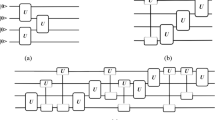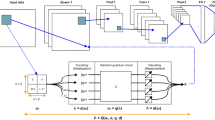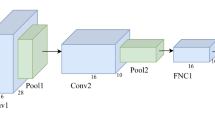Abstract
Image classification has an important role in many machine learning applications. Numerous classification techniques based on quantum machine learning have been reported recently. In this article, we investigate the features of the quanvolutional neural network—a hybrid quantum-classical image classification technique, which is inspired by the convolutional neural network and has the potential to outperform current image processing techniques. We improve the training strategy and evaluate the classification tasks on three traditional public datasets in terms of different topologies, sizes, and depths of filters. Finally, we propose four efficient configurations for the quanvolutional neural network to improve image classification.






Similar content being viewed by others
Availability of data and materials
Data are available from the corresponding authors upon reasonable request. All codes used in this study are available on GitHub (https://github.com/vutuanhai237/DynamicQNN).
References
Abbas A, Sutter D, Zoufal C, Lucchi A, Figalli A, Woerner S (2021) The power of quantum neural networks. Nat Comput Sci 1:403–409. https://doi.org/10.1038/s43588-021-00084-1
Alchieri L, Badalotti D, Bonardi P, Bianco S (2021) An introduction to quantum machine learning: from quantum logic to quantum deep learning. Quantum Mach Intell 3:28. https://doi.org/10.1007/s42484-021-00056-8
Araujo IF, Park DK, Petruccione F, da Silva AJ (2021) A divide-and-conquer algorithm for quantum state preparation. Sci Rep 11:6329. https://doi.org/10.1038/s41598-021-85474-1
Chai J, Zeng H, Li A, Ngai EW (2021) Deep learning in computer vision: a critical review of emerging techniques and application scenarios. Mach Learn Appl 6:100134. https://doi.org/10.1016/j.mlwa.2021.100134. Retrieved from https://www.sciencedirect.com/science/article/pii/S2666827021000670
Chen SY-C, Wei T-C, Zhang C, Yu H, Yoo S (2022) Quantum convolutional neural networks for high energy physics data analysis. Phys Rev Res 4:013231. https://doi.org/10.1103/PhysRevResearch.4.013231. Retrieved from https://link.aps.org/doi/10.1103/PhysRevResearch.4.013231
Duong T, Truong ST, Tam M, Bach B, Ryu J-Y, Rhee J-KK (2022) Quantum neural architecture search with quantum circuits metric and Bayesian optimization. Preprint at arXiv:2206.14115
Giovannetti V, Lloyd S, Maccone L (2008a) Architectures for a quantum random access memory. Phys Rev A 78:052310. https://doi.org/10.1103/PhysRevA.78.052310. Retrieved from https://link.aps.org/doi/10.1103/PhysRevA.78.052310
Giovannetti V, Lloyd S, Maccone L (2008b) Quantum random access memory. Phys Rev Lett 100:160501. https://doi.org/10.1103/PhysRevLett.100.160501. Retrieved from https://link.aps.org/doi/10.1103/PhysRevLett.100.160501
Hai VT, Viet NT, Ho LB (2023) Variational preparation of entangled states on quantum computers. Preprint at arXiv:2306.17422
He K, Zhang X, Ren S, Sun J (2016) Deep residual learning for image recognition
Henderson M, Shakya S, Pradhan S, Cook T (2020) Quanvolutional neural networks: powering image recognition with quantum circuits. Quantum Machine Intelligence 2(1):2. https://doi.org/10.1007/s42484-020-00012-y
Houssein EH, Abohashima Z, Elhoseny M, Mohamed WM (2022) Machine learning in the quantum realm: the state-of-the-art, challenges, and future vision. Expert Syst Appl 194:116512. https://doi.org/10.1016/j.eswa.2022.116512. Retrieved from https://www.sciencedirect.com/science/article/pii/S0957417422000136
Hur T, Kim L, Park DK (2022) Quantum convolutional neural network for classical data classification. Quantum Mach Intell 4(1):3. https://doi.org/10.1007/s42484-021-00061-x
Jeswal SK, Chakraverty S (2019) Recent developments and applications in quantum neural network: a review. Arch Comput Methods Eng 26(4):793–807. https://doi.org/10.1007/s11831-018-9269-0
Kou C, Yang H (2023) A mini-batch stochastic conjugate gradient algorithm with variance reduction. J Glob Optim 87(2):1009–1025. https://doi.org/10.1007/s10898-022-01205-4
Krizhevsky A, Hinton G et al (2009) Learning multiple layers of features from tiny images
Krizhevsky A, Sutskever I, Hinton GE (2017) Imagenet classification with deep convolutional neural networks. Commun ACM 60(6):84–90. https://doi.org/10.1145/3065386
Lecun Y, Bottou L, Bengio Y, Haffner P (1998) Gradient-based learning applied to document recognition. Proc IEEE 86(11):2278–2324. https://doi.org/10.1109/5.726791
Li Z, Liu F, Yang W, Peng S, Zhou J (2022) A survey of convolutional neural networks: analysis, applications, and prospects. IEEE Trans Neural Netw Learn Syst 33(12):6999–7019. https://doi.org/10.1109/TNNLS.2021.3084827
Liu J, Lim KH, Wood KL, Huang W, Guo C, Huang H-L (2021) Hybrid quantum-classical convolutional neural networks. Sci China Phys Mech Astron 64(9):290311. https://doi.org/10.1007/s11433-021-1734-3
Mattern D, Martyniuk D, Willems H, Bergmann F, Paschke A (2021) Variational quanvolutional neural networks with enhanced image encoding. Preprint at arXiv:2106.07327
Preskill J (2018) Quantum computing in the NISQ era and beyond. Quantum 2:79. https://doi.org/10.22331/q-2018-08-06-79
Schuld M, Killoran N (2022) Is quantum advantage the right goal for quantum machine learning? PRX Quantum 3:030101. https://doi.org/10.1103/PRXQuantum.3.030101. Retrieved from https://link.aps.org/doi/10.1103/PRXQuantum.3.030101
Schuld M, Petruccione F (2018) Supervised learning with quantum computers (Vol. 17). Springer
Schuld M, Petruccione F (2021) Machine learning with quantum computers (No. 2). Springer
Sim S, Johnson PD, Aspuru-Guzik A (2019) Expressibility and entangling capability of parameterized quantum circuits for hybrid quantum-classical algorithms. Adv Quantum Technol 2(12):1900070. https://doi.org/10.1002/qute.201900070
Simonyan K, Zisserman A (2014) Very deep convolutional networks for large-scale image recognition. Preprint at arXiv:1409.1556
Szegedy C, Liu W, Jia Y, Sermanet P, Reed S, Anguelov D, Rabinovich A (2015) Going deeper with convolutions
Tulbure A-A, Tulbure A-A, Dulf E-H (2022) A review on modern defect detection models using DCNNs – deep convolutional neural networks. J Adv Res 35:33–48. https://doi.org/10.1016/j.jare.2021.03.015. Retrieved from https://www.sciencedirect.com/science/article/pii/S2090123221000643
Verdon G, McCourt T, Luzhnica E, Singh V, Leichenauer S, Hidary J (2019) Quantum graph neural networks. Preprint at arXiv:1909.12264
Voulodimos A, Doulamis N, Doulamis A, Protopapadakis E (2018) Deep learning for computer vision: a brief review. Comput Intell Neurosci 2018:7068349. https://doi.org/10.1155/2018/7068349
Wei S, Chen Y, Zhou Z, Long G (2022) A quantum convolutional neural network on NISQ devices. AAPPS Bulletin 32(1):2. https://doi.org/10.1007/s43673-021-00030-3
Weigold M, Barzen J, Leymann F, Salm M (2022) Data encoding patterns for quantum computing. Proceedings of the 27th conference on pattern languages of programs. USA, The Hillside Group
Wierichs D, Izaac J, Wang C, Lin CY-Y (2022) General parameter-shift rules for quantum gradients. Quantum 6:677. https://doi.org/10.22331/q-2022-03-30-677
Wu J, Li Q (2022) Poster: scalable quantum convolutional neural networks for edge computing
Xiao H, Rasul K, Vollgraf R (2017). Fashion-MNIST: a novel image dataset for benchmarking machine learning algorithms. Preprint at arXiv:1708.07747
Zhang S-X, Hsieh C-Y, Zhang S, Yao H (2022) Differentiable quantum architecture search. Quantum Sci Technol 7(4):045023
Zoufal C, Lucchi A, Woerner S (2019) Quantum generative adversarial networks for learning and loading random distributions. Quantum Information 5(1):103. https://doi.org/10.1038/s41534-019-0223-2
Acknowledgements
The authors thank Bui Cao Doanh for a helpful discussion of the experiment’s setup in this work.
Funding
This research was supported by the VNUHCM-University of Information Technology’s Scientific Research Support Fund.
Author information
Authors and Affiliations
Contributions
Hai. V. T. conducted the experiments, and Bao. P. T. and Lawrence. H. L. proposed the methodology. All authors reviewed the manuscript.
Corresponding author
Ethics declarations
Conflict of interest
The authors declare no competing interests.
Additional information
Publisher's Note
Springer Nature remains neutral with regard to jurisdictional claims in published maps and institutional affiliations.
Appendix
Appendix
As mentioned in Section 2.2, the quantum compiling technique will consume large resources when dealing with a very large dataset. Thus, we can convert patches of each \(\{X_j\}\) in dataset \(\mathcal {X}\) based on filter size f, store it, and then use it later:
where \(\varvec{\theta }^{QC}_{i,j}\) is the optimal parameter in the quantum compiling process and the depth of the encoder is the depth \(U_{\text {QC}, f}\). Then, this quantum dataset can be used in various problems.
Rights and permissions
Springer Nature or its licensor (e.g. a society or other partner) holds exclusive rights to this article under a publishing agreement with the author(s) or other rightsholder(s); author self-archiving of the accepted manuscript version of this article is solely governed by the terms of such publishing agreement and applicable law.
About this article
Cite this article
Vu, T.H., Le, L.H. & Pham, T.B. Exploring the features of quanvolutional neural networks for improved image classification. Quantum Mach. Intell. 6, 29 (2024). https://doi.org/10.1007/s42484-024-00166-z
Received:
Accepted:
Published:
DOI: https://doi.org/10.1007/s42484-024-00166-z




